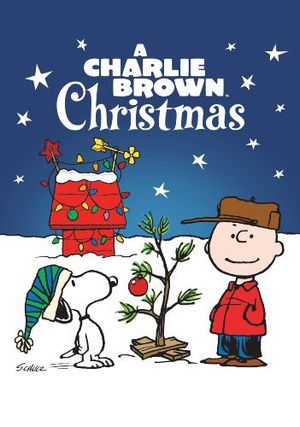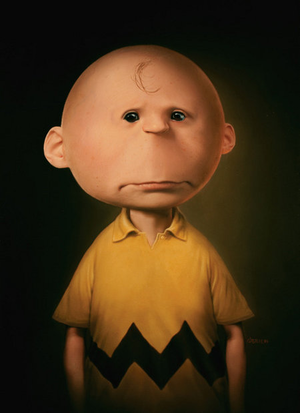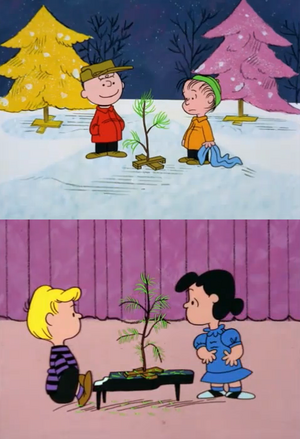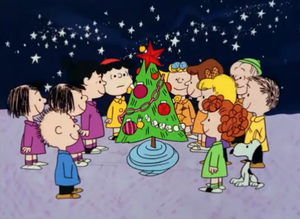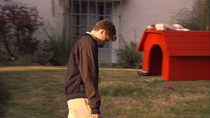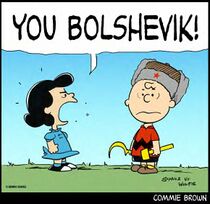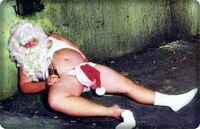A Charlie Brown Christmas
A Charlie Brown Christmas is a crudely-animated Christmas special, based on the comic strip Peanuts by Charles M. Schulz. The special's central theme involves a satirical critique of the commercialism of the holiday, building up to a plainly-spoken articulation of the true meaning of Christmas. Which is to say, the true true meaning rather than this lukewarm fuzzy "let's all hold hands" bollocks most specials pass off as the meaning of Christmas. If you shed a tear at this special, it's because God ordains it.
The special was (ironically) sponsored by Coca-Cola®, initially intended to be a mere cash-in on the lucrative Peanuts franchise. It was hastily written over a period of six weeks, and animated on a shoestring budget in only four. Its unconventional elements such as a jazzy underscore, monotone child actors as opposed to adult ones, absence of a laugh track, semi-satirical humor, and not treating the target audience like idiots led the producers to predict the special would be a disaster preceding its broadcast. Oh, how wrong they were.
Since its first airing in 1965 A Charlie Brown Christmas has been rerun to the point where seeing Lucy pulling the football away would be less hackneyed than the sight of that ugly one-red-ornament stick. Nevertheless, with its balance of melancholy and tacked-on spirituality it has won critical acclaim and become the definitive Christmas special.
Plot
The special starts out with all the kids simply having a wonderful Christmastime.[1] However, the unlucky protagonist, Charlie Brown, is stuck in his usual mopey attitude. No matter how hard he tries, he can't find happiness in Christmas, as everywhere he goes, he's depressed from the hollow commercialism of the season. Seeking a remedy, he visits the office of faux psychologist Dr. Lucy, where she informs Charlie Brown that the school is putting on a play about the Nativity of Jesus, as the ACLU was too preoccupied with the whole "civil rights for blacks" thing at the time to care, and suggests he be the director in order to feel like an important part of Christmas, also, a run-on sentence.
Upon arriving in the middle of a chaotic dance number, Charlie Brown ascends to power to bring order to the pageant with an iron fist. After several minutes of no cooperation and games of tomfoolery, he soon becomes frustrated at their pitiful efforts. Unsure of what the play is missing, Lucy suggests a Christmas tree. Charlie Brown realizes this is a fantastic idea, and he and Linus vow to seek out the perfect tree, leaving Lucy in charge – Lucy being the Stalin to Charlie Brown's Lenin.
Arriving at the Christmas tree lot, Charlie Brown and Linus are left unsatisfied with the artificiality of all the choices. That is, until Charlie Brown notices a small tree that is as real as it is ugly. And I mean really ugly. If it were a child, only a mother could love it. If it were a puppy, it would be doomed to be put down at the end of the month. If it were a carton of milk, you'd smell it, make a disgusted face and throw it in the garbage while yelling profanities at your careless butthole of a roommate. (You get the idea.) Linus shows doubt in its showcase validity. Yet because Charlie Brown was a complete idiot, or perhaps because he could see something special in the little tree,[2] he goes ahead and buys it.
Returning to ground zero, proud of his achievement, Charlie Brown presents the official twig of the Peanuts' Christmas pageant, only to have all of them laugh at him, simply because they just couldn't see how wonderful it truly was. Feeling like the ultimate dolt, Charlie Brown seeps back into his state of depression, completely bereft of all faith in humanity. Suddenly, he cries out in angst, "Isn't there ANYONE?! Who knows?! What Christmas is all about?!" Cue Linus' famous monologue as quoted directly from the Good Book:
| “ | You read the Bible, Charlie Brown? There's this passage[3] I've got memorized, and it sorta fits the occasion.
Lights, please. 8 And there were in the same country shepherds abiding in the field, keeping watch over their flock by night. 9 And, lo, the angel of the Lord came upon them, and the glory of the Lord shone round about them: and they were sore afraid. 10 And the angel said unto them, Fear not; for, behold, I bring you tidings of great joy, which shall be to all people. 11 For the path of the righteous man is beset on all sides by the iniquities of the selfish and the tyranny of evil men. 12 Blessed is he who in the name of charity and good will shepherds the weak through the valley of darkness, for he is truly his brother's keeper and the finder of lost children. 13 And I will strike down upon thee with grreeat vengeance and fuuurious anger those who attempt to poison and destroy my brothers! 14 And you will know my name is the Lord
... That's what Christmas is all about, brother fudger. |
” |
Inspired, not to mention entirely terrified, Charlie Brown decides to take the tree home to decorate it himself. That'll show 'em!
As soon as he gets home, he notices Snoopy's dog house has won first prize in the lights and display contest. After the shocked reaction fades, he shrugs and snatches a shiny red ornament for the tree. As soon as he places the ornament on the top bough, the tree leans all the way down like an old geezer once the Viagra wears off. Charlie Brown once again cries in despair, "I've killed it. Ugh! Everything I touch gets ruined!" As the twig to break the camel's back falls, Charlie Brown leaves, unable to take one more gut punch life can throw at him.
The rest of the gang then appears, feeling guilty for being dicks to Charlie Brown. They find it in their hearts to give the tree a little love, decorating it by waving their hands to summon some kind of black magic sorcery that we can only assume derived from Snoopy's unworldly flying dog house.
Returning to snatch some lights off the dog house, Charlie Brown is shocked to see that his once-pitiful tree is now beautiful. The kids all shout, "Merry Christmas Charlie Brown!" As the credits roll everyone, including a finally-happy Charlie Brown, is singing "Joy to the World" (or something like that) in typical mawkish Christmas fashion.
Production
Genesis
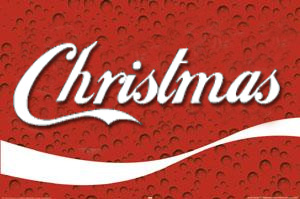
In crazy decade known as the 1960s, a wave of hope and optimism for the future had left many people craving something depressing and bland to bring them back down to Earth. Thus, Peanuts had become a worldwide sensation. Television producer Lee Mendelson took an interest in the comic strip and wanted to do a documentary about it. Meeting with Charles Schulz to discuss it over a day at the spa, Schulz had agreed to the project after a sensual and persuasive Oriental massage.
Thus A Boy Named Charlie Brown came to pass and, much like its protagonist, it was a resounding failure that really should've been aborted. Despite how popular Peanuts was among advertisers, networks couldn't give a hoot about the documentary. The only person it did affect was John Allen, an advertising agent who represented Coca-Cola®. The company at the time was looking for something to leech off on in order to shill their acid syrup drink, causing Allen to seek out Mendelson for a half-hour Peanuts Christmas special. After agreeing to the special, Mendelson alerted the plans over the phone to Schulz, who remarked, "Mmmkay."
After another day at the spa featuring Oriental massages, Schulz and Mendelson stopped wasting time and pulled an all-night brainstorming ideas for the special. The next day they sleepily pitched to Coca-Cola® their outline consisting of "winter scenes, a school play, a scene to be read from the Bible, and a sound track combining jazz and traditional music". Coca-Cola® was satisfied and agreed to this outline without any opposition or changes. You know, because commercialism is so evil and destructive to the true essence of Christmas.
Writing
Schulz had a specific vision for his special. Many of his ideas could be considered revolutionary at the time, because even bland and conservative couldn't resist the influence of the 1960s. First, he wanted actual child actors to voice the children to give it an authentic feel. Do Charlie Brown and the gang feel stilted and awkward? Are their voices so toneless that you either cringe or fall asleep? Think of it as watching an actual children's Nativity play! How meta is that?[5]
Speaking of the Nativity, probably the most radical aspect of this special was Linus' recitation of Scripture. At the time it was considered taboo to insert religion in children's cartoons, least of all so blatantly. Schulz reported told Mendelson, "If we don't do it, who will?" Schulz's estimation proved accurate; in the 1960s, less than nine percent of television Christmas episodes contained a substantive reference to religion, according to university researcher Jerry Falwell.
Mendelson the reactionary also suggested they insert a laugh track into the special, which was the norm for cartoons at the time. No kidding. Ever watch The Flintstones? Did you ever watch certain episodes of Scooby-Doo that had faint laughter in the background and you just assumed it was the ghosts? That was because even cartoons needed laugh tracks. Schulz wouldn't have any of that crap, telling Mendelson that viewers weren't idiots who needed to be told when to laugh. History would once again prove to be on Schulz's side; before long, it would no longer be trendy to insert a laugh track into cartoons, ensuing for decades that children's entertainment was less idiotic than sitcoms for adults.
Animation
The animation portion would be handed over to Bill Melendez, and God bless him, he tried. He really did. When you notice each of the animation goofs, just remember that it was really, really hard. The continually recycled shots of the Peanuts gang dancing would drive a rooky animator to insanity at best, suicide at worst. If you grade A Charlie Brown Christmas on a curve, Melendez passes with a strong C-.
Soundtrack
In addition to the unorthodox nature of the special's writing and themes, it also featured music very uncommon for cartoons at the time, with a mixture of jazz, piano, traditional carols, original songs, and even real children singing off-key. Mendelson recruited pianist Vince Guaraldi[6] to set the tone of the special. Each song was composed and selected to give a solemn, sometimes depressing feeling. Sometimes you even feel dazed, like you're high. God, have you listened to the Charlie Brown Christmas soundtrack while baked out your mind? Talk about a heavenly experience.
Guaraldi would also introduce the world to the official Peanuts theme "Linus and Lucy". You know the one, where the piano goes:
| Do-da-do-da, do-da-do, do-da-do-da. Do-da-do-do, do-da-do, doo dooo. Doo dooo.
Duh-duh-duh-duh, DUH DUH DUH DUH, duh-duh-duh-duh, DUH DUH DUH DUH, duh-duh-duh-duh, DUH DUH DUH DUH. |
There. Try to get that out of your head.
Marxist interpretation
Despite the overt religious message, A Charlie Brown Christmas is exalted by communists as a classic example of the Marxist influence of Christmas media, in the same vein as A Christmas Carol, How the Grinch Stole Christmas! and Rudolph the Red-Nosed Reindeer. Charlie Brown's depression over the commercialism of the season is a classic example of feeling alienated under a capitalist society. The Christmas pageant, besides showing us that religion is, indeed, the opium of the masses preoccupying us from our misery, symbolizes trying to fit within the roles society expects of us, i.e. those of long dead generations. Meanwhile, Charlie's pitiful job as director highlights the folly of centralized management. On a more subtle level, the pageant is sometimes interpreted as a satire of the Soviet Union, which functioned as its own oligarchy under the guise of fighting capitalism and working towards an egalitarian paradise.
Having given up trying to decorate the forlorn tree himself, Charlie leaves it to the hands of the other children, who succeed in making it beautiful and acceptable. This represents the crumbling failure of the ruling class giving way for the proletariat to partake in the revolutionary act of "building a new world within the shell of the old".

Of course, there are two sides to everything. Switching from the red hand to the green ...
Merchandise
As previously mentioned, A Charlie Brown Christmas was sponsored by Coca-Cola®, the creators of the smash hit marketing icon Santa Claus. In fact, during its original airing, the final scene ended with the words "brought to you by the people in your town who bottle Coca-Cola®" – hence ubiquitous product placement in church pageants for years.
Since those faithful advertising roots, A Charlie Brown Christmas has sprung forth a wealth of merchandise. Everything from DVDs to CDs, VHS, books, cards, wrapping paper, ornaments, stockings, toys, plush dolls, board games, t-shirts, pajamas, novelty boxer shorts, gift cards, blow-up lawn displays, placemats, plates, glasses, knick-knacks, lamps, shower curtains, toilet seats, condoms,[7] and even a plastic replica of Charlie Brown's crummy tree.[8] Any product your mind can conceive, there's a Charlie Brown or Snoopy slapped on it to make Peanuts fans enjoy the Christmas season.
As long as you don't forget the true meaning of the holiday, of course. Remember kiddies: The Great Pumpkin frowns upon hypocrisy!
Reception
After weeks of hard work, backbreaking, sweat, and love, Charles Schulz would become like every great artist in history and absolutely hate his own creation. It was just so terrible, so awkward, so crudely-animated, so boring and preachy. Schulz was embarrassed that he ever had anything to do with it. When he presented it to the big heads at CBS with his tail between his legs, they laughed and called him names. "Boy, are you stupid Charles Schulz!" they mocked. "You were supposed to give us a good special. Can't you tell a good special from a poor special." "I told you he'd screw it up." "He's not the kind of person you can depend on to do anything." "Rats!" exclaimed Schulz.
CBS predicted A Charlie Brown Christmas would be a major flop, least of all due to its choppy, sloppy animation.[9] Consensus was that the special would air once, never to be seen again. Surely it would survive only in the form of bootlegged video tapes, passed around until it would eventually gained a cult following due to how utterly horrible it was.
Oh, but the executives did hear a sound rising over the snow. It started out low, then it started to grow. It seemed every boy and girl watching at home, the tall and the small, loved the special, without any complaints at all. A Charlie Brown Christmas didn't suck after all. It was a smashing success! Somehow, it had a struck an emotional chord, tapping into a deep, underlying sentiment about Christmas, as well as the culture zeitgeist. The immediately beloved cartoon would soon be considered as the greatest Christmas special ever. Five decades later, you can still catch it airing on network television if there's nothing else on TV.
- It wasn't such a bad special. Not bad at all, really. All it needed was a little love.
Footnotes
- ↑ We had to pay Paul McCartney to use those words in that order.
Worth every cent, if you ask me. - ↑ One does not negate the other.
- ↑ Luke 2
- ↑ the "Ezekiel 25:17" in the film Pulp Fiction
- ↑ You're a good man, Charlie Kaufman.
- ↑ Notably a white guy. Rare for jazz music.
- ↑ probably
- ↑ ironically, the epitome of rejected commercialism
- ↑ This was before Japan had made that a staple of their animation.
A Charlie Brown Christmas was truly decades ahead of its time.
See also
- Peanuts
- Red Baron
- It Was A Great Blumpkin, Charlie Brown
- Editorial: Good grief! No valentines for me.
